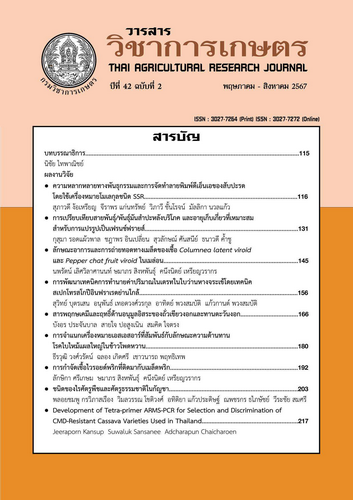การเปรียบเทียบสายพันธุ์/พันธุ์มันสำปะหลังบริโภค และอายุเก็บเกี่ยวที่เหมาะสม สำหรับการแปรรูปเป็นเฟรนช์ฟรายส์
DOI:
https://doi.org/10.14456/thaidoa-agres.2024.11คำสำคัญ:
มันสำปะหลังบริโภค, เฟรนช์ฟรายส์มันสำปะหลัง, การทดสอบทางประสาทสัมผัสบทคัดย่อ
เฟรนช์ฟรายส์โดยทั่วไปทำจากมันฝรั่ง เป็นอาหารว่างที่ได้รับความนิยม การนำมันสำปะหลังซึ่งประเทศไทยมีศักยภาพในการผลิตสูง และมีราคาถูกกว่ามันฝรั่งมาผลิตเฟรนช์ฟรายส์ จะเป็นการส่งเสริมการใช้มันสำปะหลังเพื่อการบริโภคเพิ่มขึ้น จึงทำการศึกษาเปรียบเทียบมันสำปะหลัง จำนวน 6 สายพันธุ์/พันธุ์ ได้แก่ CMRE60-03-02 CMRE60-03-13 OMRE60-02-61 OMRE60-03-09 ห้านาที และ ระยอง2 ที่อายุเก็บเกี่ยว 8 10 และ 12 เดือน ต่อผลผลิต เนื้อสัมผัส และรสชาติเมื่อนำมาผลิตเป็นเฟรนช์ฟรายส์ โดยแบ่งการทดลองเป็น 3 แปลงทดลอง ในแต่ละแปลงวางแผนการทดลองแบบสุ่มในบล็อกสมบูรณ์ จำนวน 4 ซ้ำ ดำเนินการปลูกพร้อมกัน ผลการทดลองพบว่า การเก็บเกี่ยวที่อายุ 8 เดือน สายพันธุ์ OMRE60-02-61 ให้ผลผลิตหัวสด 2,877 กก./ไร่ ใกล้เคียงกับพันธุ์ห้านาที เฟรนช์ฟรายส์ที่ทำจากสายพันธุ์ OMRE60-02-61 มีคุณภาพด้านเนื้อสัมผัสค่อนข้างสูงกว่าพันธุ์ห้านาที และคะแนนการยอมรับทางประสาทสัมผัสด้าน สี รสชาติ เนื้อสัมผัส และความชอบโดยรวมสูงกว่าพันธุ์ห้านาทีทุกด้าน ที่อายุ 10 เดือน สายพันธุ์ CMRE60-03-13 ให้ผลผลิตหัวสด 2,929 กก./ไร่ สูงกว่าพันธุ์ห้านาที 31% เฟรนช์ฟรายส์ที่ทำจากสายพันธุ์ CMRE60-03-13 คะแนนการยอมรับทางประสาทสัมผัสทุกด้านเทียบเท่าพันธุ์ห้านาที แต่มีคุณภาพด้านเนื้อสัมผัสน้อยกว่า และการเก็บเกี่ยวที่อายุ 12 เดือน สายพันธุ์ OMRE60-02-61 ให้ ผลผลิตหัวสด 2,650 กก./ไร่ ใกล้เคียงกับพันธุ์ห้านาที เฟรนช์ฟรายส์ที่ทำจากสายพันธุ์ OMRE60-02-61 มีคุณภาพด้านเนื้อสัมผัส และได้คะแนนการยอมรับทางประสาทสัมผัสใกล้เคียงกับพันธุ์ห้านาที แต่ผู้ทดสอบชิมให้การยอมรับเฟรนช์ฟรายส์จากมันสำปะหลังพันธุ์ห้านาทีมากกว่า ดังนั้น ในภาพรวม มันสำปะหลังสายพันธุ์ OMRE60-02-61 ที่อายุเก็บเกี่ยว 8 เดือน เหมาะสำหรับการผลิตเฟรานช์ฟรายส์มากที่สุด เนื่องจากให้ผลผลิตสูงและได้คะแนนการยอมรับจากผู้บริโภคสูงกว่าพันธุ์ห้านาที
เอกสารอ้างอิง
จิณณจาร์ หาญเศรษฐสุข. 2552. คุณสมบัติและประโยชน์ของหัวและแป้งมันสำปะหลัง. ศูนย์วิจัยพืชไร่ระยอง กรมวิชาการเกษตร. 80 หน้า.
ไชยรัตน์ เพ็ชรชลานุวัฒณ์ กล้าณรงค์ ศรีรอด วิจารณ์ วิชชุกิจ เจริญศักดิ์ โรจนฤทธิ์พิเชษฐ์ วุฒิศักดิ์ พรพรหมประทาน และวัฒนะ วัฒนานนท์. 2539. ผลของพันธุ์และอายุการเก็บเกี่ยวที่มีต่อ ผลผลิต ความหนืด และลักษณะของสารละลายแป้ง. วารสารวิชาการเกษตร. 14(1): 11-17.
ปรารถนา เงินฉลาด อริสา นนทะโคตร์ และมณฑา หมีไพรพฤกษ์. 2564. ปริมาณไซยาไนด์ และฤทธิ์การต้าน อนุมูลอิสระในเฟรนช์ฟรายส์มันสำปะหลังพันธุ์พิรุณ 2. หน้า 889-895. ใน: รายงานสืบเนื่องจากการ ประชุมวิชาการระดับชาติสำหรับนักศึกษา ครั้งที่ 1. มหาวิทยาลัยราชภัฏกำแพงเพชร. 22 กุมภาพันธ์ 2564.
มหาวิทยาลัยเกษตรศาสตร์. 2564. การเก็บเกี่ยวมันสำปะหลัง. แหล่งข้อมูล: https://icassava.eng.ku.ac.th/wiki/index.php?title=การเก็บเกี่ยวมันสำปะหลัง & mobileaction=toggle_view_desktop. สืบค้น: 31 ตุลาคม 2566.
เมดไทย. 2563. มันสําปะหลัง สรรพคุณและประโยชน์ของมันสำปะหลัง 12 ข้อ !. แหล่งข้อมูล: https://medthai.com/มันสำปะหลัง/. สืบค้น: 27 กันยายน 2566.
วัฒนะ วัฒนานนท์ ชาญ ถิรพร โสภณ สินธุประมา และ Kazuo Kawano. 2528. ผลผลิตของมันสำปะหลังที่เก็บเกี่ยวอายุสั้นในสภาพปริมาณน้ำฝนต่างกัน. วารสารวิชาการเกษตร. 3: 139-148.
ศุภชัย สารกาญจน์ อัจฉรา ลิ่มศิลา และวัฒนะ วัฒนานนท์. 2546. เปรียบเทียบเบื้องต้นพันธุ์มันสำปะหลัง (ปลายฝน) ใน ผลงานฉบับเต็มขอประเมินเพื่อแต่งตั้งให้ดำรงตำแหน่งนักวิชาการเกษตร 7ว.. สถาบันวิจัยพืชไร่. 45 หน้า.
สถาบันวิจัยพืชไร่และพืชทดแทนพลังงาน. 2558ก. การเพิ่มประสิทธิภาพมันสำปะหลัง. กรมวิชาการเกษตร กระทรวงเกษตรและสหกรณ์. 82 หน้า.
สถาบันวิจัยพืชไร่และพืชทดแทนพลังงาน. 2558ข. การบันทึกข้อมูลมันสำปะหลัง. กรมวิชาการเกษตร กระทรวงเกษตรและสหกรณ์. 48 หน้า.
สถาบันวิจัยและพัฒนาแห่งมหาวิทยาลัยเกษตรศาสตร์. 2558. มันสำปะหลัง: การจำแนกชนิดและสายพันธุ์ มันสำปะหลัง. แหล่งข้อมูล: https://www3.rdi.ku.ac.th/?p=18052. สืบค้น: 24 กันยายน 2566.
สุรินทร์ ตั้งมั่นคงวรกุล. 2544. การศึกษาการสลายตัวของไซยาไนด์จากมันสำปะหลังด้วยเอนไซม์. วิทยานิพนธ์ปริญญามหาบัณฑิต. มหาวิทยาลัยเทคโนโลยีพระจอมเกล้าธนบุรี.
สุวลักษณ์ อะมะวัลย์. 2564. โครงการวิจัยโครงการวิจัยและพัฒนาพันธุ์มันสำปะหลังเพื่อเพิ่มประสิทธิภาพการผลิต. รายงานโครงการวิจัย. กรมวิชาการเกษตร. หน้า 250-300.
สำนักงานคณะกรรมการอาหารและยา. 2557. มาตราฐานโคเด็กซ์. แหล่งข้อมูล: https://www.foodfti.com/มาตรฐานโคเด็กซ์/5492b062fc1a14a01d0004ed. สืบค้น: 10 มกราคม 2567.
อนุชิต ทองกล่ำ นเรศ สอนหลักทรัพย์ ชาญ ถิรพร และโสภณ สินธุประมา. 2518. ฤดูปลูกและอายุเก็บเกี่ยวที่เหมาะสมของมันสำปะหลัง. ใน: รายงานผลการทดลองมันสำปะหลัง พ.ศ. 2518. สาขาพืชหัว กรมวิชาการเกษตร.
อัจฉรา ลิ่มศิลา และจรุงสิทธิ์ ลิ่มศิลา. 2537. ชนิดและพันธุ์มันสำปะหลัง. ใน: เอกสารวิชาการมันสำปะหลัง. ศูนย์วิจัยพืชไร่ระยอง สถาบันวิจัยพืชไร่ กรมวิชาการเกษตร กระทรวงเกษตรและสหกรณ์. กรุงเทพฯ.
โอภาษ บุญเส็ง. 2549. มันสำปะหลังทำเฟรนช์ฟราย. กสิกร. 79(1): 24-28.
Bruijin, G.H. 1971. Etude du character cyanoglucosides, linamarin and lotaustralin in higher plants. Phytochemistry. 4: 127-1 31.
Herawati, H. and E. Kamsiati. 2019. Effect of process technology and coating material on the cassava stick characteristics. Journal of Physics. 1295(1): 012071.
Ogunsua, A. O. 1989. Total cyanide levels in bread made from wheat/cassava composite flours. International Journal of Food Science and Technology. 24: 361-365.
Padmaja, G. 1995. Cyanide detoxification in cassava for food and feed uses. Critical Reviews in Food Science and Nutrition. 35(4): 299-339.
Reis, R. C., L. A. de Oliveira, J. M. Almeida, P. de J. Neta, F. D. Santos, V. da S. Santos and R. S. Cruz. 2021. Culinary quality and sensory profile of cassava varieties harvested at different ages. Ciências Agrárias. 42 (2): 657-678.
Williams, H.J. and T.G. Edwards. 1980. Estimation of cyanide with alkaline picrate. Journal of the Science of Food and Agriculture. 31(1): 15-22.
ดาวน์โหลด
เผยแพร่แล้ว
รูปแบบการอ้างอิง
ฉบับ
ประเภทบทความ
สัญญาอนุญาต
ลิขสิทธิ์ (c) 2024 วารสารวิชาการเกษตร

อนุญาตภายใต้เงื่อนไข Creative Commons Attribution-NonCommercial-NoDerivatives 4.0 International License.
วารสารวิชาการเกษตร



